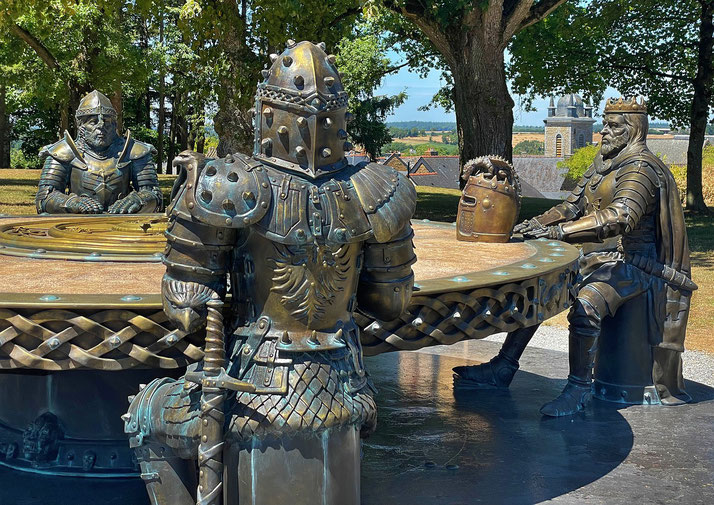Is there any historical evidence for King Arthur?

The legend of King Arthur has captivated the imagination of people around the world for centuries.
The story of a noble king who pulled the sword from the stone and united the people of Britain under his rule has been retold countless times in literature, movies, and television shows.
But was King Arthur a real historical figure, or just a myth?
Who was King Arthur?
King Arthur is a legendary figure who is said to have ruled Britain in the late 5th and early 6th centuries.
According to legend, he was a great warrior who led the Britons in their fight against the invading Saxons.
The stories about King Arthur have been preserved in oral tradition and written accounts for over a thousand years.
There is much debate among historians about whether King Arthur was a real historical figure or simply a mythological character.
Some scholars argue that there may have been a historical figure who inspired the legend, while others believe that the stories are entirely fictional.
In the legend, King Arthur is often portrayed as a wise and just ruler who establishes a code of chivalry and knights of the Round Table to uphold it.
He is known for his courage, honor, and loyalty to his people, and in later stories, is said to have been aided by the wizard Merlin in his battles against the Saxons.
What historical sources do we have?
Historia Brittonum (9th century)
The Historia Brittonum, written in the 9th century by the monk Nennius, is one of the earliest surviving written accounts of Arthur.
In this work, Arthur is described as a military leader who fought against the Saxons and other enemies of the British people.
Nennius also mentions 12 battles that Arthur fought, including the Battle of Badon, which was said to have been a decisive victory over the Saxons.
The Historia Brittonum provides some of the earliest historical evidence for Arthur's existence, but the details it provides are relatively sparse and often contradictory.
Also, there is no mention of many of the key elements of the legend, including a magical sword called Excalibur, a wizard named Merlin, or other legendary figures such as Guinevere and Lancelot.
Annales Cambriae (10th century)
The Annales Cambriae, a chronicle of Welsh history written in the 10th century, mentions Arthur several times.
The annals record the Battle of Badon as a historical event that took place in the year 516, and they also mention other battles in which Arthur fought.
However, like the Historia Brittonum, the Annales Cambriae provides relatively little information about Arthur's life and deeds.
Geoffrey of Monmouth (12th century)
The most famous work about King Arthur is Geoffrey of Monmouth's History of the Kings of Britain, written in the 12th century.
In this work, Arthur is portrayed as a powerful king who conquers much of England and establishes a golden age of chivalry and honor.
Geoffrey of Monmouth's work was hugely influential in shaping the Arthurian legend, and many of the key elements of the legend, such as Merlin and the magical elements of the narrative, can be traced back to his work.
However, Geoffrey's work is largely a work of fiction, and there is little historical evidence to support the many claims he makes about Arthur.

Later authors
In addition to Geoffrey of Monmouth's History of the Kings of Britain, there are many other medieval texts that mention King Arthur.
These include the French romances of Chrétien de Troyes and the English works of Thomas Malory, among others.
These works continue to shape the popular image of King Arthur as a noble and chivalrous figure, and introduce elements such as Camelot and the Round Table, and Lancelot and the Holy Grail, but again, they are largely works of fiction that draw heavily on earlier legends and myths.
What archaeological evidence survives?
Despite numerous archaeological digs over the years, no direct evidence has been found that definitively proves the existence of King Arthur.
However, some archaeologists and historians believe that certain sites and artifacts may provide clues that support the idea of a historical Arthur.
One of the most famous sites associated with King Arthur is Tintagel Castle in Cornwall, England.
In the 1930s, archaeologists excavated the site and uncovered a number of artifacts, including pottery and a stone inscribed with the name "Artognou."
Some scholars believe that this name may be a variant of "Arthur" and that it suggests that Tintagel was an important center of power in Arthur's time.
Another site that has been associated with King Arthur is Cadbury Castle in Somerset, England.
Local tradition and legend identify it as the possible site of Camelot, Arthur's legendary court.
The site was the location of a major hillfort during the 6th century and archaeological digs at Cadbury Castle have revealed evidence of a large building which may have been a Great Hall.
While these sites and artefacts do not provide definitive proof of King Arthur's existence, they do suggest that the legend of Arthur may have been based on historical events and figures.
Why is the Arthurian legend so popular?
The Arthurian legend has captured the imaginations of people for centuries, and its enduring popularity can be attributed to several factors.
First and foremost, the legend is full of romance and adventure. The stories feature knights in shining armor, quests for treasure and glory, and powerful wizards and sorceresses.
These themes have universal appeal and continue to resonate with audiences of all ages.
The idea of embarking on a noble quest, fighting for justice and honor, and overcoming obstacles along the way is deeply appealing to many people.

The Arthurian legend is also rich in symbolism and allegory. The stories have been interpreted in many different ways over the years, and their symbolism and allegory have made them a source of inspiration for artists, writers, and filmmakers.
The story of the sword in the stone, for example, has been interpreted as a metaphor for the challenges of leadership, while the quest for the Holy Grail has been seen as a symbol of spiritual enlightenment.
This depth of meaning and interpretation has helped to keep the legend fresh and relevant over time.
The historical significance of the Arthurian legend cannot be ignored. While the historical accuracy of the legend remains uncertain, the stories have played an important role in shaping the cultural identity of Britain and its people.
The legend has been used to promote national unity and pride, and its influence can be seen in everything from literature and art to politics and popular culture.
What can we conclude?
In the end, the question of whether King Arthur was a real historical figure may never be fully resolved.
The legend of Arthur has become so deeply ingrained in British culture that it is difficult to separate fact from fiction.
However, even if Arthur did not exist in the way that he is portrayed in the legend, his story has had a lasting impact on British history and culture, and his legend will likely continue for centuries to come.
What do you need help with?
Download ready-to-use digital learning resources
Copyright © History Skills 2014-2025.
Contact via email
With the exception of links to external sites, some historical sources and extracts from specific publications, all content on this website is copyrighted by History Skills. This content may not be copied, republished or redistributed without written permission from the website creator. Please use the Contact page to obtain relevant permission.





